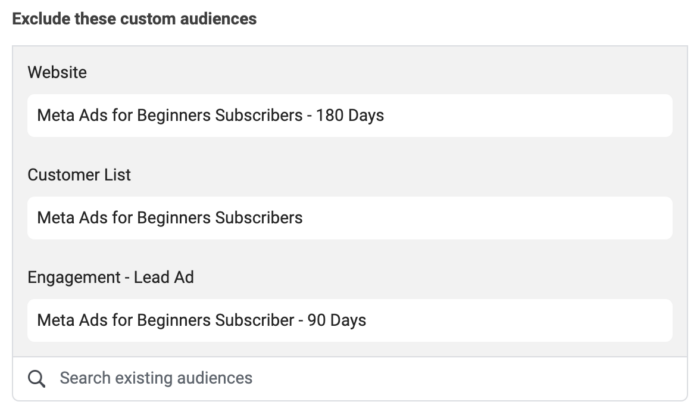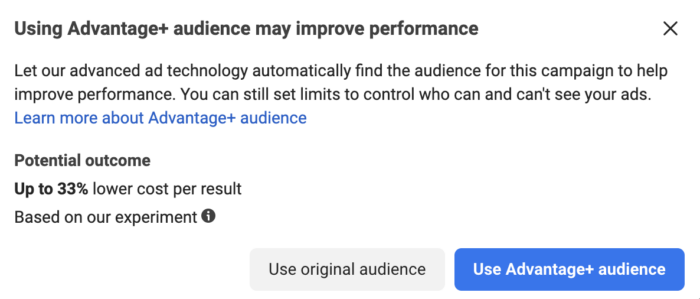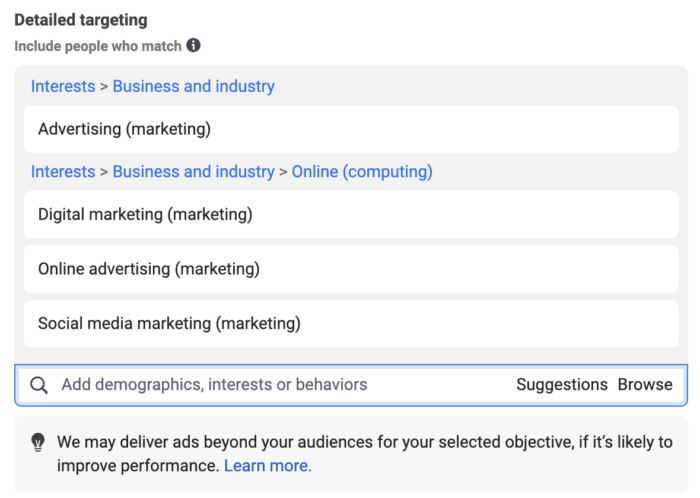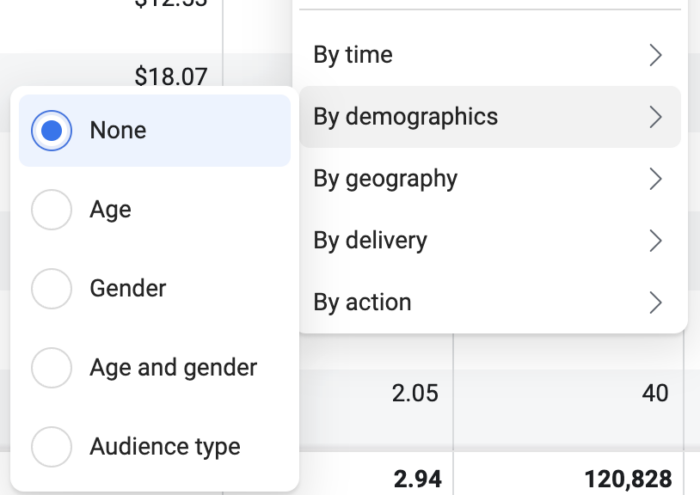Meta advertising has changed rapidly the past few years, and that leads to several common targeting mistakes. These errors are largely due to a combination of ignorance and stubbornness. If you’re making mistakes with targeting now, it’s likely one of these six things. And it’s impacting your results…Follow us!
Improper Use of Exclusions
The improper use of exclusions can go two ways.
Nonexistent or incomplete use of exclusions.
The use of exclusions is a fundamental way to avoid wasted ad spend. It’s a step that’s often missed by beginner advertisers. If you’re promoting a product that can only be purchased once, there’s no need to show ads to people who have already purchased it.
While that customer list custom audience is a start, it’s unlikely to exclude all current members due to matching incompleteness. When an exclusion is required, you should exclude that group in as many ways as possible.
An example is if you ever run lead ads using instant forms while also having a landing page on your website, there are at least three different ways you can exclude people who already performed this action: Lead form custom audience, website custom audience, and customer list custom audience.
2. Overuse of exclusions.
While you should use exclusions, you can overdo it. It’s not uncommon for advertisers to exclude all current customers when promoting a product that current customers can buy. They consider it a “true prospecting” campaign and only go after completely new customers.
This is missing a golden opportunity. Your satisfied customers are the ones who are most likely to buy again and again. Excluding them eliminates the least challenging sale.
The response from those who take this approach is that they have a separate ad set for remarketing. But if you have one ad set for broad remarketing and one for prospecting, you’re going to drastically increase the costs to reach your remarketing audience. Remarketing audiences are small audiences, which translates to higher frequencies and CPMs.
It’s inefficient and unnecessary now. Don’t exclude current customers unless those customers can’t buy the product you’re promoting.
Expansion Ignorance
Many advertisers hate hearing this, but your targeting inputs mean less than ever before. This isn’t to say you should remove all targeting inputs and go completely broad (though it’s something to try). But even when you do provide inputs, the targeting is often going broader.
Either advertisers don’t know or they’re willfully ignorant about the role of audience expansion. And it doesn’t necessarily matter whether you’re using the original audience options or Advantage+ Audience
1. Original audience options.
You’re resistant to the newfangled targeting of Advantage+ Audience and insist on kicking it old school. So you opt-out of it by making a couple of extra clicks to use the original audience options. You even click past the “Are you sure?” message about how it could lead to higher costs.
You enter in a bunch of interests and behaviors. This is how to go after your ideal customer, you think. These detailed targeting options define the exact person you want to reach. You’re doing something super smart.
But, you’re also optimizing for conversions, link clicks, or landing page views. And when you do that, your audience is automatically expanded using Advantage Detailed Targeting.
2. Advantage+ Audience.
It’s possible you may not even know there is a “new way” and “old way.” You spend significant time and budget trying to find the ideal targeting using custom audiences, lookalike audiences, and detailed targeting.
But, guess what? This targeting is only a suggestion.
It doesn’t matter whether you’re optimizing for conversions, link clicks, or landing page views. It doesn’t matter whether you’re using custom audiences, lookalike audiences, or if you click a box to expand the audience.
Your inputs are only suggestions and people well beyond this group will see your ads.
Your inability to understand and appreciate that targeting is expanding beyond your inputs may not be a mistake in and of itself. But this will lead to mistakes as well as wasted budget and time.
Too Narrow When Optimizing for Conversions
Many advertisers treat targeting like it’s 2017. There’s no better example than when optimizing for any type of conversion.
There was a time when a critical step was picking the targeting. Which interests, behaviors, lookalike audiences, or custom audiences made a huge difference to your results?
But when you’re optimizing for conversions now, your targeting inputs aren’t nearly as important as they once were. This is seen in the examples above when running manual Sales campaigns using either Advantage+ Audience or the original audience options, as described in the previous section.
But Advantage+ Shopping Campaigns go even further. You don’t provide any targeting inputs in this case. Meta does it all automatically.
There are two important factors that contribute to how your audience is chosen…
Performance goal optimization.
In the case of Advantage+ Shopping Campaigns, it’s typically a purchase (though it can be any standard or custom event now). The algorithm’s primary focus for delivery is to get you as many of that goal action as possible within your budget.
Success is determined by the ability to satisfy that goal. Adjustments will be made to delivery to get you more of those actions where possible.
Prior activity.
Whether you’re using Advantage+ Audience without targeting inputs or creating an Advantage+ Shopping Campaign, the initial focus of targeting is determined for you based on your pixel activity, conversion history, and prior engagement with your ads.
The mistake is that advertisers go far too narrow when optimizing for conversions when it simply isn’t necessary. Your biggest obstacle to success is limited budget and audience size. The more you limit the audience, the more you will restrict the algorithm and drive up your costs.
It’s also not as easy to go narrow as it once was, for the reasons already described. In some cases, your attempts are futile and the audience will expand anyway.
But, if you provide broad custom audiences while using the original audiences and turn off Advantage Custom Audience, you are likely doing more harm than good. You may get some short-term results. But you’ll exhaust that audience and run into a ceiling quickly.
It’s an obstacle that’s easily avoidable since Meta will automatically go after relevant people based on pixel activity, conversion data, and ad activity anyway — if you simply allow it.
Overdoing Demographic Granularity
Once again, there was a time and place for this. Especially when optimizing for any type of conversion, those times have passed.
We all did this years ago, and it was smart advertising at the time. We constructed the profile of our ideal customer. Their likes and dislikes, age range and gender, even their incomes and zip codes.
You may have even run breakdown to find the groups of people by age and gender that lead to the best results so that you can then focus only on them.
You think that’s necessary now, but it just isn’t.
I’ve written before about how this may be necessary when optimizing for top of the funnel actions. But if we’re to be honest, nearly all top of funnel advertising is flawed anyway.
It’s one thing if you are unable to sell to customers under a certain age. Or your product is for women. There’s no reason to get cute messing with these settings simply because you believe that your product appeals more to men between the ages of 35-44.
If your goal is to drive more purchases, don’t try to outsmart the algorithm. It will learn. By restricting options, you are likely driving up costs unnecessarily — and limiting your pool of potential customers.
Too Broad When Optimizing for Top of Funnel
I alluded to it above. Avoid restricting your audience unnecessarily when optimizing for any type of conversion (especially a purchase). But that changes when optimizing for top of funnel actions.
Why? Because ad set optimization is literal. The algorithm’s only goal will be to get the action that you want. And while that is why you should limit restrictions when optimizing for conversions, it’s why top of funnel optimization can fail spectacularly.
Let’s say you’re optimizing for post engagement. You are a women’s clothing brand. You are hoping to attract potential customers by showcasing your new line. Because you optimized for post engagement, the algorithm will only care about getting you engagement. It doesn’t matter (to Meta) whether that engagement is from a potential customer or not.
So, you’ll get plenty of engagement if you don’t limit by gender. Comments, video views, reactions, and image clicks. But you can bet that the vast majority of this engagement won’t be helpful. You have to put guardrails on targeting when optimizing for these top of funnel actions because after all of these years, there are still very few ways to optimize for high quality actions that aren’t conversions.
I realize this sounds like a contradiction. I’ve given two very opposite sets of advice:
- Stop restricting your targeting
- Restrict your targeting. But the important context is whether you’re optimizing for the top or bottom of the funnel.
On one hand, I’d tell you it may be best to avoid running campaigns for engagement or clicks at all. But if you do, you’d better use some strict targeting — and make sure that the audience can’t be expanded.
Unnecessary Extra Ads Sets for Cold Targeting
This is connected to expansion ignorance. It’s also related to advertisers’ refusal to evolve with how things work now.
The idea that this would be more efficient than combining the cold targeting ad sets into one is illogical. It goes against how it works now and opposes Meta’s recommendations. In the past, it made sense to split out ad sets for different cold targeting segments. Not only were there more interests and behaviors to choose from, but you could have very distinct groups of people. The overlap could have been controlled.
But that’s not the case now. If you’re using Advantage+ Audience (and that’s what Meta recommends), your inputs are only suggestions. If you’re using the original audience options with interests and lookalike audiences, those audiences are expanded. There may be initial differences in performance between your ad sets in the beginning. Some of it will be based on your inputs and some will be due to randomness. But if they’re all optimized the same way and run the same ads, the differences will eventually be minimal. The algorithm will expand to show to people most likely to convert. That overlap is not beneficial. You’re undoubtedly getting flooded with recommendations about auction overlap and audience fragmentation with suggestions to combine your ad sets. You’re willfully ignoring those warnings.
In most cases, you should use one ad set per campaign for cold targeting. If you need further evidence that this is where things are headed, look to Advantage+ Shopping Campaigns. You can’t even create a second ad set in that case.








This stage is fabulous. The splendid material exhibits the proprietor’s enthusiasm. I’m overwhelmed and expect additional such incredible substance.
This gateway is incredible. The splendid data displays the administrator’s earnestness. I’m overwhelmed and expect more such astounding material.